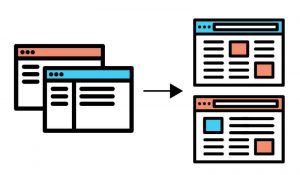
Optimizing a marketing strategy or SEO campaign is only possible through proper testing. Failure to do this and act on those results can quickly see a website slip down the ranks. You may be familiar with the common method known as A/B testing, but when was the last time you conducted a multivariate test?
What’s the difference?
As the name would suggest, multivariate testing involves analysis of multiple variables to uncover the best potential outcome. Unlike an A/B test where you’re measuring the performance of two versions of a web page, multivariate takes a far more intricate approach.
Individual features within a single webpage can be changed and coupled with other variables to provide a variety of possible combinations. Of course, the ultimate goal is providing insight into which of those combinations works best for your conversions.
As an example, you may choose to test 5 variations of a content banner with 2 variations of an image. This would give multiple possible combinations. With traffic directed to these different web pages, you can now determine the most effective design.
Slightly more complex than its A/B counterpart, it can have tons of benefits, allowing you to determine which features play the most important role in terms of optimizing visitor conversion and creating an unrivalled user experience.
Advantages
Multivariate tests may be most suited for the advanced marketer but its impact can be effective across a variety of campaigns. It’s especially useful for those looking to improve a specific area of conversion. Whether it be joining a mailing list or sharing content, altering a variety of elements at the same time, for the same purpose could make a surprising difference.
It can also avoid the need to conduct several A/B tests on the same page. As you can include as many variations as you wish, it can provide more meaningful results in a shorter space of time. What’s more, you can use the results from one page and apply them to the entire website.
Disadvantages
This form of testing can only be applied to those sites with a significant amount of traffic. A/B testing splits traffic 50/50 but multivariate can be split into much small segments – quarters, sixths, eighths and more – depending on the number of variations. This means, each variation that’s being tested will receive much less traffic than the traditional A/B test.
It’s also important to consider which variables have an impact on the conversion goal before getting started. Changes to a headline may improve conversion while using different images have little or no effect. In these circumstances, A/B testing would be the more straightforward approach.
Few methods of testing are more effective at specific web page analysis than the multivariate approach. Taking all the guess work out of website development, it’s the only guaranteed way to discover the best combinations in layout and design. Give it a try and you could see a major improvement in conversions.
Digital & Social Articles on Business 2 Community(33)







